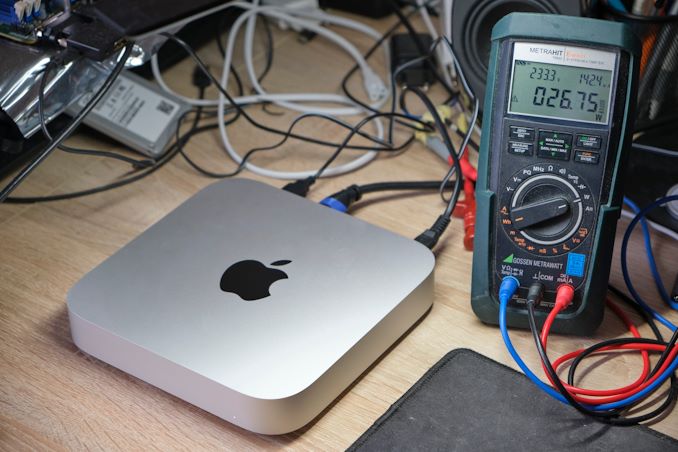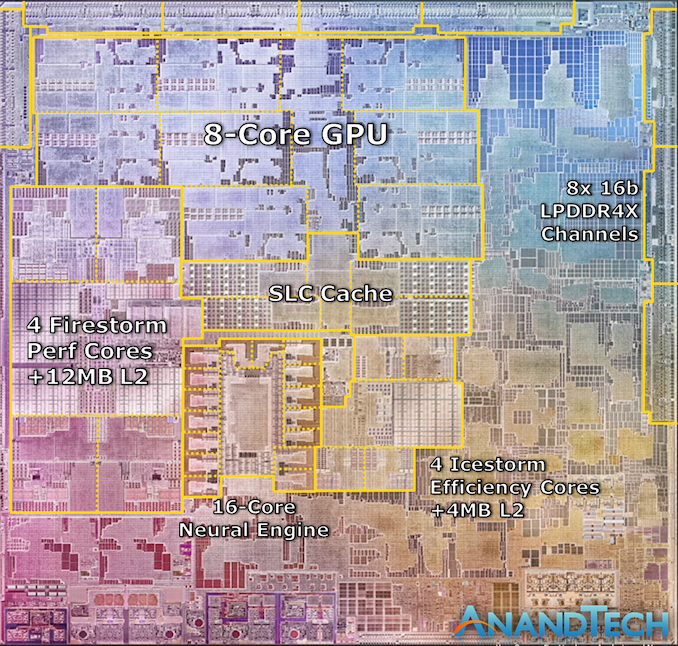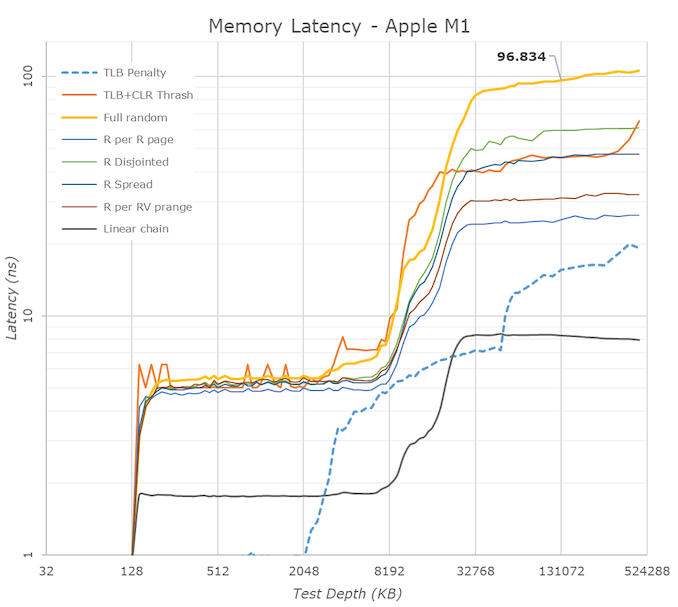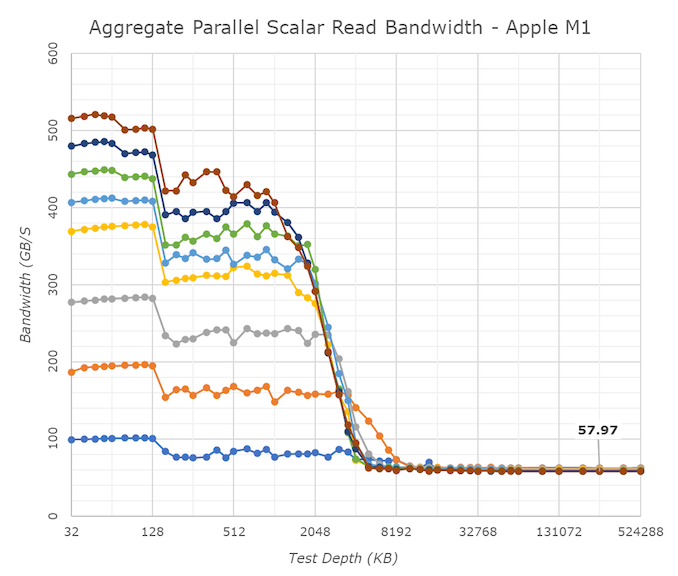The 2020 Mac Mini Unleashed: Putting Apple Silicon M1 To The Test
by Andrei Frumusanu on November 17, 2020 9:00 AM EST
Last week, Apple made industry news by announcing new Mac products based upon the company’s new Apple Silicon M1 SoC chip, marking the first move of a planned 2-year roadmap to transition over from Intel-based x86 CPUs to the company’s own in-house designed microprocessors running on the Arm instruction set.
During the launch we had prepared an extensive article based on the company’s already related Apple A14 chip, found in the new generation iPhone 12 phones. This includes a rather extensive microarchitectural deep-dive into Apple’s new Firestorm cores which power both the A14 as well as the new Apple Silicon M1, I would recommend a read if you haven’t had the opportunity yet:
Since a few days, we’ve been able to get our hands on one of the first Apple Silicon M1 devices: the new Mac mini 2020 edition. While in our analysis article last week we had based our numbers on the A14, this time around we’ve measured the real performance on the actual new higher-power design. We haven’t had much time, but we’ll be bringing you the key datapoints relevant to the new Apple Silicon M1.
Apple Silicon M1: Firestorm cores at 3.2GHz & ~20-24W TDP?
During the launch event, one thing that was in Apple fashion typically missing from the presentation were actual details on the clock frequencies of the design, as well as its TDP which it can sustain at maximum performance.
We can confirm that in single-threaded workloads, Apple’s Firestorm cores now clock in at 3.2GHz, a 6.66% increase over the 3GHz frequency of the Apple A14. As long as there's thermal headroom, this clock also applies to all-core loads, with in addition to 4x 3.2GHz performance cores also seeing 4x Thunder efficiency cores at 2064MHz, also quite a lot higher than 1823MHz on the A14.
Alongside the four performance Firestorm cores, the M1 also includes four Icestorm cores which are aimed for low idle power and increased power efficiency for battery-powered operation. Both the 4 performance cores and 4 efficiency cores can be active in tandem, meaning that this is an 8-core SoC, although performance throughput across all the cores isn’t identical.
The biggest question during the announcement event was the power consumption of these designs. Apple had presented several charts including performance and power axes, however we lacked comparison data as to come to any proper conclusion.
As we had access to the Mac mini rather than a Macbook, it meant that power measurement was rather simple on the device as we can just hook up a meter to the AC input of the device. It’s to be noted with a huge disclaimer that because we are measuring AC wall power here, the power figures aren’t directly comparable to that of battery-powered devices, as the Mac mini’s power supply will incur a efficiency loss greater than that of other mobile SoCs, as well as TDP figures contemporary vendors such as Intel or AMD publish.
It’s especially important to keep in mind that the figure of what we usually recall as TDP in processors is actually only a subset of the figures presented here, as beyond just the SoC we’re also measuring DRAM and voltage regulation overhead, something which is not included in TDP figures nor your typical package power readout on a laptop.

Starting off with an idle Mac mini in its default state while sitting idle when powered on, while connected via HDMI to a 2560p144 monitor, Wi-Fi 6 and a mouse and keyboard, we’re seeing total device power at 4.2W. Given that we’re measuring AC power into the device which can be quite inefficient at low loads, this makes quite a lot of sense and represents an excellent figure.
This idle figure also serves as a baseline for following measurements where we calculate “active power”, meaning our usual methodology of taking total power measured and subtracting the idle power.
During average single-threaded workloads on the 3.2GHz Firestorm cores, such as GCC code compilation, we’re seeing device power go up to 10.5W with active power at around 6.3W. The active power figure is very much in line with what we would expect from a higher-clocked Firestorm core, and is extremely promising for Apple and the M1.
In workloads which are more DRAM heavy and thus incur a larger power penalty on the LPDDR4X-class 128-bit 16GB of DRAM on the Mac mini, we’re seeing active power go up to 10.5W. Already with these figures the new M1 is might impressive and showcases less than a third of the power of a high-end Intel mobile CPU.
In multi-threaded scenarios, power highly depends on the workload. In memory-heavy workloads where the CPU utilisation isn’t as high, we’re seeing 18W active power, going up to around 22W in average workloads, and peaking around 27W in compute heavy workloads. These figures are generally what you’d like to compare to “TDPs” of other platforms, although again to get an apples-to-apples comparison you’d need to further subtract some of the overhead as measured on the Mac mini here – my best guess would be a 20 to 24W range.
Finally, on the part of the GPU, we’re seeing a lower power consumption figure of 17.3W in GFXBench Aztec High. This would contain a larger amount of DRAM power, so the power consumption of Apple’s GPU is definitely extremely low-power, and far less than the peak power that the CPUs can draw.
Memory Differences
Besides the additional cores on the part of the CPUs and GPU, one main performance factor of the M1 that differs from the A14 is the fact that’s it’s running on a 128-bit memory bus rather than the mobile 64-bit bus. Across 8x 16-bit memory channels and at LPDDR4X-4266-class memory, this means the M1 hits a peak of 68.25GB/s memory bandwidth.
In terms of memory latency, we’re seeing a (rather expected) reduction compared to the A14, measuring 96ns at 128MB full random test depth, compared to 102ns on the A14.
Of further note is the 12MB L2 cache of the performance cores, although here it seems that Apple continues to do some partitioning as to how much as single core can use as we’re still seeing some latency uptick after 8MB.
The M1 also contains a large SLC cache which should be accessible by all IP blocks on the chip. We’re not exactly certain, but the test results do behave a lot like on the A14 and thus we assume this is a similar 16MB chunk of cache on the SoC, as some access patterns extend beyond that of the A14, which makes sense given the larger L2.
One aspect we’ve never really had the opportunity to test is exactly how good Apple’s cores are in terms of memory bandwidth. Inside of the M1, the results are ground-breaking: A single Firestorm achieves memory reads up to around 58GB/s, with memory writes coming in at 33-36GB/s. Most importantly, memory copies land in at 60 to 62GB/s depending if you’re using scalar or vector instructions. The fact that a single Firestorm core can almost saturate the memory controllers is astounding and something we’ve never seen in a design before.
Because one core is able to make use of almost the whole memory bandwidth, having multiple cores access things at the same time don’t actually increase the system bandwidth, but actually due to congestion lower the effective achieved aggregate bandwidth. Nevertheless, this 59GB/s peak bandwidth of one core is essentially also the speed at which memory copies happen, no matter the amount of active cores in the system, again, a great feat for Apple.
Beyond the clock speed increase, L2 increase, this memory boost is also very likely to help the M1 differentiate its performance beyond that of the A14, and offer up though competition against the x86 incumbents.
- Page 1: Apple Silicon M1: Recap, Power Consumption
- Page 2: Benchmarks: Whatever Is Available
- Page 3: M1 GPU Performance: Integrated King, Discrete Rival
- Page 4: SPEC2006 & 2017: Industry Standard - ST Performance
- Page 5: SPEC2017 - Multi-Core Performance
- Page 6: Rosetta2: x86-64 Translation Performance
- Page 7: Conclusion & First Impressions













682 Comments
View All Comments
Spunjji - Monday, November 23, 2020 - link
Not really - I don't own a Mac and don't ever plan to unless Boot Camp comes back. You're mistaken to assume I'm personally invested in this; I just don't like shitposters very much.taligentia - Tuesday, November 17, 2020 - link
Not sure what you're rambling about.Macbook Air, Mac Mini and the 13 MBP were always their low-end models.
Wait until their iMac Pro, Mac Pro are released. It will truly shake up the professional market.
KoolAidMan1 - Tuesday, November 17, 2020 - link
They're better at video editing, color correction, and image processing than other PCs.Show me a desktop PC that can scrub 8k video in DaVinci Resolve with no framedrops like the entry-level M1 in a 13" MBP can. Its exceedingly rare and incredibly expensive. I have a Threadripper workstation and am salivating at these
KoolAidMan1 - Tuesday, November 17, 2020 - link
If this is "entry level" then I can't wait to see what their high end machines with 32GB+ of RAM look like next yearhaghands - Tuesday, November 17, 2020 - link
Did you look at a single benchmark? Are benchmarks too complicated for your single brain cell?Silma - Tuesday, November 17, 2020 - link
It's good to have more competition.However, let's temper these praises: 2 of the most paramount reasons explaining this chip speed are not apple: microarchitecture is ARM, production is TSMC 5 nm.
The speed and power consumption of any Intel processor but made in 5 nm would be much similar to that of the M1.
Even from AMD we can expect automatically much better results in 5 nm than in 7 nm.
I would be very interested in seeing how competitive another ARM based TSCM 5 nm based SoC vs the M1. Perhaps from Qualcom or someone else.
Otritus - Tuesday, November 17, 2020 - link
Tsmc's 5nm node offers about a 30 decrease in power consumption over 7nm. That would imply a 28-34 watt tdp at 7nm which still keeps it ahead in efficiency. In terms of performance, no AMD and Intel would not perform better on 5nm. There is no reason to believe the TSMC 5nm process can clock higher(or even as high) than the 7nm process. Since performance is equal to ipc times clock speed, a new microarchitecture would be needed to perform better. Apple has over a 50 percent ipc lead over intel and over a 40 percent ipc lead over AMD.AlexDaum - Tuesday, November 17, 2020 - link
An AMD or Intel CPU on 5nm would not gain performance by higher clock speeds, but gain it using a wider CPU design, larger caches, more ALUs, probably a better branch predictor and larger reorder buffer. The M1 has a whopping 16 billion transistors, AMD renoir only 9.6 billion, so they could add a lot more logic on the same chip size, which would lead to better performance.The biggest challenge with scaling x86 CPUs to higher performance seems to be building wide decoders (AMD and Intel only have 4 wide decode, M1 has 8 wide, 1 x86 instruction can do more than 1 ARM64 instruction, but not twice as much).
andreltrn - Tuesday, November 17, 2020 - link
The problem with the X86 instruction set is that it has instruction of different size that don't match a wider architecture favorably. It is not that easy to achieve the high degree of parallelism of the M1 architecture with the X86 Instruction set. The 16 billions transistors are not only for the CPU and the GPU. There is a lot more in there! You can't compare the transistor count like that. This is a SOC.Otritus - Wednesday, November 18, 2020 - link
@AlexDaum1) As I said a new microarchitecture would be needed.
2) Ice/tiger lake already has 5 decoders (4 simple + 1 complex), and tremont has 6 decoders (run as 2 sets of 3, but intel says it can run as 1 set of 6).
3) Apples firestorm cores was designed for 2020 using the latest technology. Sunny cove was supposed to launch in 2017/18, with the next gen microarchitecture coming 2020/21. Intel also got lazy and didn't feel a need to speed up microarchitecture development and improve performance tremendously. So, intel is at 4/5 decoders with weak ipc compared to the competition.
4) AMD is still at 4 decoders because they have a limited engineering budget and need to focus on getting the best ROI. I would imagine zen 4 or zen 5 would look into going much wider because lots of the other performance enhancing routes have already been investigated, and AMD is in a better financial situation.